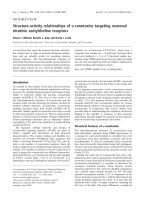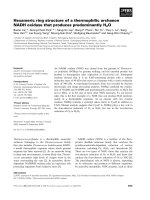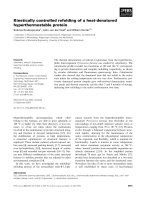báo cáo khoa học:" Malignant fibrous histiocytoma of the face: report of a case" ppsx
Bạn đang xem bản rút gọn của tài liệu. Xem và tải ngay bản đầy đủ của tài liệu tại đây (743.31 KB, 5 trang )
BioMed Central
Page 1 of 5
(page number not for citation purposes)
Head & Face Medicine
Open Access
Case report
Malignant fibrous histiocytoma of the face: report of a case
László Seper*
1
, Richárd Schwab
†2
, Sirichai Kiattavorncharoen
†1,3
,
Andre Büchter
†1,4
, Ágnes Bánkfalvi
†5,6
, Ulrich Joos
†1
, József Piffkó
†1
and
Birgit Kruse-Loesler
†1
Address:
1
Department of Cranio-Maxillofacial Surgery, University of Muenster, Waldeyerstr. 30, 48149 Muenster, Germany,
2
Cooperative Research
Center, Semmelweis University, POB 131, 1367 Budapest, Hungary,
3
Department of Oral and Maxillo-Facial Surgery, Mahidol University, 6 Yothe
Rd.Rajthevee, 10400 Bangkok, Thailand,
4
Group practice Engelke, Büchter, Immenkamp, Hohenzollernring 10, 48145 Muenster, Germany,
5
Gerhard-Domagk-Institute of Pathology, University of Muenster, Domagkstraße 17, 48149 Muenster, Germany and
6
Departments of Pathology
and Neuropathology, University of Duisburg-Essen Medical School, Hufelandstraße 55, 45122 Essen, Germany
Email: László Seper* - ; Richárd Schwab - ; Sirichai Kiattavorncharoen - ;
Andre Büchter - ; Ágnes Bánkfalvi - ; Ulrich Joos - ;
József Piffkó - ; Birgit Kruse-Loesler -
* Corresponding author †Equal contributors
Abstract
Background: Soft tissue sarcomas in the head and neck region are rare and often present a
difficult differential diagnosis. The aim of our presentation is to point out the complexity of the
diagnosis, treatment and follow up.
Case presentation: An eighty-seven year old female patient was referred to our unit with a fast
growing brownish lump on the face. Four months beforehand, a benign fibrous histiocytoma (BFH)
had been removed from the same location by excision biopsy with wide tumour-free resection
margins. Excision biopsy of the recurrent lesion revealed a malignant fibrous histiocytoma (MFH).
Radical tumour resection was completed by extended parotidectomy and neck dissection; the skin
defect was covered by a regional bi-lobed flap. No adjuvant radio- or chemotherapy was
administered. Full functional and cosmetic recovery was achieved; follow-up has been uneventful
more than two years postoperatively.
Discussion: Malignant transformation of BFH is extremely rare and if so, extended radical surgery
may give a fair chance for a favourable outcome even in patients with advanced age.
Background
Soft tissue tumours in the head and neck region some-
times display borderline pathological features regarding
benign or malignant behaviour. Despite similar histolog-
ical patterns the clinical outcome is often different and
difficult to predict.
Malignant fibrous histiocytoma [MFH] is a primitive,
often pleomorphic sarcoma consisting of partly fibrob-
last-like, partly histiocyte-like cells. It has been classified
as a distinct histopathological entity since the nineteen-
sixties [1]. Nowadays, it is one of the most common soft
tissue sarcomas of late adult life, with a male predomi-
nance since all neoplasms of mesodermal origin previ-
Published: 18 October 2007
Head & Face Medicine 2007, 3:36 doi:10.1186/1746-160X-3-36
Received: 20 October 2006
Accepted: 18 October 2007
This article is available from: />© 2007 Seper et al; licensee BioMed Central Ltd.
This is an Open Access article distributed under the terms of the Creative Commons Attribution License ( />),
which permits unrestricted use, distribution, and reproduction in any medium, provided the original work is properly cited.
Head & Face Medicine 2007, 3:36 />Page 2 of 5
(page number not for citation purposes)
ously regarded as sarcomas of uncertain origin are now
included in the category of MFH [2]
Changing of the histological picture during progression of
the disease and transformation of borderline-benign
lesions to malignant phenotype has been described.
Reported incidence of malignant transformation lies
around 1% [3].
Benign fibrous histiocytoma [BFH] is the most common
benign neoplasm in practically all localizations affecting
the epidermis. The proliferative, atypical or borderline
type is a cell-dense variant mostly growing faster and
greater in size, with characteristically frequent local recur-
rences, reported incidence lying at 3–5%. Both BFH and
its borderline variant are known not to give either haema-
togenous or loco-regional metastases to lymph-nodes [4].
The aim of our presentation is to point out the complexity
of the diagnosis, treatment and follow up of patients with
soft tissue tumours of borderline character.
Case presentation
An eighty-seven year old woman was referred to our
department because of a fast-growing, dark-brownish,
indurated skin nodule sized 3 cm in diameter, which infil-
trated the skin and the deeper soft tissue layers of the face
(Fig 1.) Four months beforehand, a benign cutaneous his-
tiocytoma (BFH) had been removed from the same loca-
tion by excision biopsy (Fig. 2a–d), which had been a
painless, slow-growing, brownish lump not exceeding 1
cm in diameter clinically. Surgical margins had been dis-
ease-free.
Excision biopsy of the current lesion revealed an infiltra-
tive, well-vascularised mesenchymal neoplasm contain-
ing pleomorphic tumour cells, increased mitotic count
with some atypical mitoses, and myxoid stroma rich in
collagen fibres. Immunohistochemistry was strongly pos-
itive for vimentin, and negative for cytokeratin, smooth-
muscle actin, desmin, S-100 and melanoma-specific anti-
gen. The MIB1 positive proliferative fraction was 50%
(Fig. 3a–d). The histological diagnosis of a "myxoid-type
malignant fibrous histiocytoma (MFH)" with tumour-free
surgical margins up to 3 cm was made [pT1a, pN0 (26/0),
pMx, R0]. Histological re-evaluation of the primary
tumour by an independent pathologist confirmed the
original diagnosis of benign fibrous histiocytoma with
ulceration, inflammation and increased cellularity ("irri-
tated BFH").
Clinical staging investigations of the current malignancy
[chest X-ray, MRI-scan of the neck and skull, abdominal
and neck ultrasound, bone scintigraphy] showed superfi-
cial infiltration of the cutis and subcutis. Neither infiltra-
tion of the Masseter nor metastases in the regional lymph
nodes or elsewhere were found. Radical excision of the
tumour was completed by parotidectomy and modified
neck dissection, which resulted in a cosmetic defect of the
right face that was immediately corrected by a local bi-
lobed flap (Fig. 4). No postoperative radio- or chemother-
apy was applied. Two years postoperatively, the patient
was alive and well with full cosmetic and functional recov-
ery. (Fig. 5) She died after a heart attack three years after
surgery without any signs of tumour recurrence or metas-
tasis. Autopsy was not carried out.
Discussion
Benign fibrous histiocytomas (BFH) are frequently found
in sun-exposed skin of the extremities and of the head and
neck. They are among the most common soft tissue
lesions of the skin [1]. Their biological nature, in particu-
lar whether they are neoplastic or reactive, has long been
disputed. Recent studies have found cytogenetic evidence
of clonal chromosomal abnormalities in a part of lesions,
which support their neoplastic origin [5]. In addition to
the common histological pattern, a number of variants are
recognized, some of which can be confused with sarcoma.
Of the cellular and atypical types, about 20% are localised
in the head and neck region, they usually grow faster and
are greater in size than the other subtypes, and tend to
recur locally (up to 26%) [4]. Reported incidence of
malignant transformation is around 1% [3].
In contrast, malignant fibrous histiocytoma (MFH) is a
sarcoma with both fibroblastic and histiocytic features. It
has been classified as a distinct histopathological entity
since the nineteen-sixties [1]. Nowadays, it is one of the
most commonly diagnosed sarcomas of late adulthood,
Preoperative view of the lesion on the right cheek: a smooth, firm nodule with wide erythematous borderFigure 1
Preoperative view of the lesion on the right cheek: a smooth,
firm nodule with wide erythematous border.
Head & Face Medicine 2007, 3:36 />Page 3 of 5
(page number not for citation purposes)
(A-D). Histopathological and immunohistochemical findings of the recurrent lesion diagnosed as malignant fibrous histiocytoma of myxoid typeFigure 3
(A-D). Histopathological and immunohistochemical findings of the recurrent lesion diagnosed as malignant fibrous histiocytoma
of myxoid type: (A) Heterogeneous fibroblastic spindle cells, histiocytic, inflammatory and pleomorphic giant cells are scattered
throughout the tumour mass embedded in myxoid stroma containing plentiful collagen fibres. (H&E, 200×). (B) Negative immu-
nohistochemical reaction for cytokeratins [pan-anti-cytokeratin antibody; KL-1 (Ventana, Germany)], (C) Strong positive reac-
tion with the MIB1 antibody showing a high proliferative activity of the tumor, MIB-1 labelling index: 50%(100×), (D) Strongly
positive immunohistochemical reaction for vimentin in the vast majority of tumour cells (400×)
(A-D). Histopathological findings of the excision biopsy specimen from the primary benign fibrous histiocytomaFigure 2
(A-D). Histopathological findings of the excision biopsy specimen from the primary benign fibrous histiocytoma: (A) The over-
lying epidermis is ulcerated and mildly acanthotic (H&E, 40×). (B) Subcutaneous cellular aggregation of spindle-shaped, fibrob-
last-like and histiocytic cells poorly demarcated from the surrounding tissues (H&E, 100×) (C) The spindled cells are arranged
in interlacing fascicles forming a storiform pattern (H&E, 200×). (D) They are accompanied by varying numbers of inflammatory
cells, foam cells and siderophages as well as proliferating capillaries (H&E, 200×)
Head & Face Medicine 2007, 3:36 />Page 4 of 5
(page number not for citation purposes)
since all neoplasms previously regarded as sarcomas of
uncertain origin are now included in this category [2].
MFH typically arises in the soft tissues of the extremities
and retroperitoneum, the head and neck region is seldom
involved. In superficial sites such as the skin, MFH may
behave in a benign fashion despite high-grade looking
and fast growing tumour cells.
The primary treatment of MFH consists of radical excision
with wide safety margins and dissection of the loco-
regional lymph nodes [6]. Post- or sometimes even preop-
erative radio- or chemotherapy may be an adjuvant
option of treatment, however their indications and effi-
cacy remain controversial [2,6]. In the present case, we
have disregarded adjuvant oncological treatment because
of the age of the patient and the lack of clear-cut evidence
for indication.
In conclusion, predicting biological behaviour on the
base of cellular features in cutaneous fibrohistiocytic
tumours is sometimes very difficult. It is well illustrated by
the present case, which showed malignant transformation
in recurrence despite the bland histopathological appear-
ance of the primary lesion. It is therefore mandatory that
patients with such lesions are closely monitored postoper-
atively, so as to be able to act promptly in case of local
recurrences. Patients' management requires close collabo-
ration between dermatologists, maxillo-facial surgeons,
radiologists and pathologists, which may result in suffi-
cient clinical outcome.
Authors' contributions
LS and RS analysed the case, reviewed all patient data and
drafted the manuscript. All authors were involved in plan-
ning the treatment. The excision biopsy, the tumour
removal and the neck dissection was carried out by SK, JP
whereas BKL carried out the plastic reconstruction of the
face. AB and ABü did the histological and immunhistolog-
ical analysis and contributed to the final conclusions of
the case report. UJ suggested the idea for the case report
and reviewed and contributed to the writing of final ver-
sion. JP, AB, ABü and BKL contributed substantially to dis-
cussions and in writing of the paper. All authors reviewed
the paper for content, and contributed to the writing of all
iterations of the paper, including the final version of the
manuscript. All authors approved the final report.
Acknowledgements
Written consent for publication was obtained from the patient or their rel-
ative.
References
1. Enzinger FM, Weiss SW: Soft tissue tumors. Third edition. Mosby,
St Louis; 1995:4-09. 83–112, 223–233
2. Sturgis EM, Potter BO: Sarcomas of the head and neck region.
Curr Opin Oncol 2003, 15:239-52.
Intraoperative view after conservative neck dissection and prior to tumour removal, parotidectomy and placing of the local bi-lobed flapFigure 4
Intraoperative view after conservative neck dissection and
prior to tumour removal, parotidectomy and placing of the
local bi-lobed flap. The safety margin is well marked around
the tumour and the preparation of the flap is completed.
Six months postoperatively with full cosmetic and functional recoveryFigure 5
Six months postoperatively with full cosmetic and functional
recovery.
Publish with Bio Med Central and every
scientist can read your work free of charge
"BioMed Central will be the most significant development for
disseminating the results of biomedical research in our lifetime."
Sir Paul Nurse, Cancer Research UK
Your research papers will be:
available free of charge to the entire biomedical community
peer reviewed and published immediately upon acceptance
cited in PubMed and archived on PubMed Central
yours — you keep the copyright
Submit your manuscript here:
/>BioMedcentral
Head & Face Medicine 2007, 3:36 />Page 5 of 5
(page number not for citation purposes)
3. O'Brien JE, Stout AP: Malignant fibrous xanthomas. Cancer 1964,
17:1445.
4. Calonje E, Mentzel T, Fletcher CD: Cellular benign fibrous histi-
ocytoma. Clinicopathologic analysis of 74 cases of a distinc-
tive variant of cutaneous fibrous histiocytoma with frequent
recurrence. Am J Surg Pathol 1994, 18:668-76.
5. Vanni R, Fletcher CD, Sciot R, Dal Cin P, De Wever I, Mandahl N,
Mertens F, Mitelman F, Rosai J, Rydholm A, Tallini G, Van Den Berghe
H, Willén H: Cytogenetic evidence of clonality in cutaneous
benign fibrous histiocytomas: a report of the CHAMP study
group. Histopathology 2000, 37:212-7.
6. Matsumoto S, Ahmed AR, Kawaguchi N, Manabe J, Matsushita Y:
Results of surgery for malignant fibrous histiocytomas of soft
tissue. Int J Clin Oncol 2003, 8:104-9.









